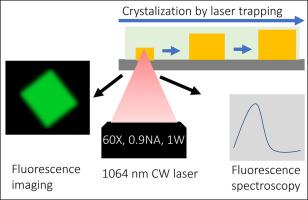捕获光线,揭示特性:激光诱捕是光致发光光谱学的有力工具
IF 4.3
Q2 CHEMISTRY, PHYSICAL
引用次数: 0
摘要
激光诱捕是一种用于操纵微观物体的非接触技术,在科学研究中的地位日益突出。与荧光光谱技术相结合,它为探索材料特性提供了一个强大的工具。本研究展示了激光捕集技术在 MAPbBr3 包晶石结晶中的应用,并将其同时用于光致发光成像。MAPbBr3 包晶石是一类具有特殊光学特性的材料,因此对各种光电应用具有吸引力。然而,传统的紫外光激发方法会导致这些材料发生相分离和机械变形。而双光子激发则具有穿透更深和减少散射干扰等优点。在这项研究中,我们利用波长为 1064 nm 的连续波激光器进行捕获和激发。MAPbBr3 包晶的吸收带范围为 400 至 540 nm,在 532 nm 波长处可进行双光子激发。通过将激光束聚焦于空气-溶液界面,我们成功地从不饱和前驱体溶液中结晶出了 MAPbBr3 包晶。同时,同一激光源还可用于光致发光成像,从而对晶体的发射特性进行实时分析。这种方法无需额外的激发光源,简化了实验装置。激光捕获和双光子激发的结合为研究包晶材料开辟了新的可能性。它为操作和表征混合包晶材料提供了一种温和、非侵入性的方法,为光电子学和能量收集等各个领域的进步铺平了道路。本文章由计算机程序翻译,如有差异,请以英文原文为准。

Trapping light, revealing properties: Laser trapping as a powerful tool for photoluminescence spectroscopy
Laser trapping, a non-contact technique for manipulating microscopic objects, has gained prominence in scientific research. When coupled with fluorescence spectroscopy, it offers a powerful tool for exploring material properties. This study demonstrates the application of laser trapping in the crystallization of MAPbBr3 perovskites and its simultaneous use for photoluminescence imaging. MAPbBr3 perovskites are a class of materials with exceptional optical properties, making them attractive for various optoelectronic applications. However, conventional excitation methods using UV light can lead to phase segregation and mechanical distortion of these materials. Two-photon excitation, on the other hand, offers advantages such as deeper penetration and reduced scattering interference. In this research, we utilize a 1064 nm continuous wave laser for both trapping and excitation purposes. The MAPbBr3 perovskite, with its absorption band ranging from 400 to 540 nm, exhibits two-photon excitation at 532 nm. By focusing the laser beam at the air-solution interface, we successfully crystallize MAPbBr3 perovskites from an unsaturated precursor solution. Simultaneously, the same laser source is used for photoluminescence imaging, allowing for real-time analysis of the crystal's emission properties. This approach eliminates the need for additional excitation sources and simplifies the experimental setup. The combination of laser trapping and two-photon excitation opens up new possibilities for studying perovskite materials. It provides a gentle and non-invasive method for manipulating and characterizing hybrid perovskites materials, paving the way for advancements in various fields such as optoelectronics and energy harvesting.
求助全文
通过发布文献求助,成功后即可免费获取论文全文。
去求助
来源期刊

Chemical Physics Impact
Materials Science-Materials Science (miscellaneous)
CiteScore
2.60
自引率
0.00%
发文量
65
审稿时长
46 days
 求助内容:
求助内容: 应助结果提醒方式:
应助结果提醒方式:


